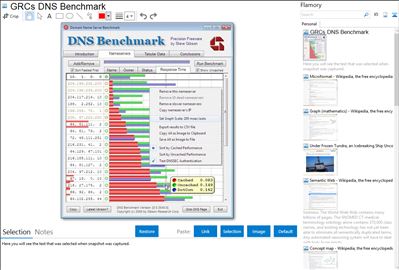 GRCs DNS Benchmark and Flamory
GRCs DNS Benchmark and Flamory
Flamory provides the following integration abilities:
- Create and use window snapshots for GRCs DNS Benchmark
- Take and edit GRCs DNS Benchmark screenshots
- Automatically copy selected text from GRCs DNS Benchmark and save it to Flamory history
To automate your day-to-day GRCs DNS Benchmark tasks, use the Nekton automation platform. Describe your workflow in plain language, and get it automated using AI.
Screenshot editing
Flamory helps you capture and store screenshots from GRCs DNS Benchmark by pressing a single hotkey. It will be saved to a history, so you can continue doing your tasks without interruptions. Later, you can edit the screenshot: crop, resize, add labels and highlights. After that, you can paste the screenshot into any other document or e-mail message.
Here is how GRCs DNS Benchmark snapshot can look like. Get Flamory and try this on your computer.

Application info
GRCs DNS Benchmark performs a detailed analysis and comparison of the operational performance and reliability of any set of up to 200 DNS nameservers (sometimes also called resolvers) at once. When the Benchmark is started in its default configuration, it identifies all DNS nameservers the users system is currently configured to use and adds them to its built-in list of publicly available “alternative” nameservers. Each DNS nameserver in the benchmark list is carefully “characterized” to determine its suitability for use as a DNS resolver. This characterization includes testing each nameserver for its “redirection” behavior: whether it returns an error for a bad domain request, or redirects a users web browser to a commercial marketing-oriented page. While such behavior may be acceptable to some users, others may find this objectionable.
When the benchmark is run, the current performance and apparent reliability of the DNS nameservers the system is currently using is compared among themselves, and also against the current performance and apparent reliability of the benchmarks list of all additional alternative nameservers.
Results are continuously displayed and updated while the benchmark is underway, with a dynamically sorted and scaled bar chart, and a tabular chart display showing the cached, uncached and “dotcom” DNS lookup performance of each nameserver. These values are determined by carefully querying each nameserver for the IP addresses of the top 50 most popular domain names on the Internet and also by querying for nonexistent domains.
Once the benchmark finishes, the results are heuristically and statistically analyzed to present a comprehensive yet simplified and understandable English-language summary of all important findings and conclusions.
Integration level may vary depending on the application version and other factors. Make sure that user are using recent version of GRCs DNS Benchmark. Please contact us if you have different integration experience.